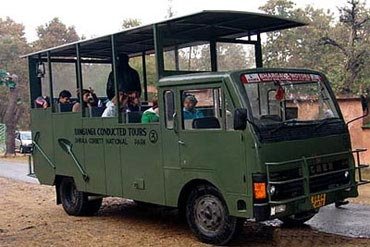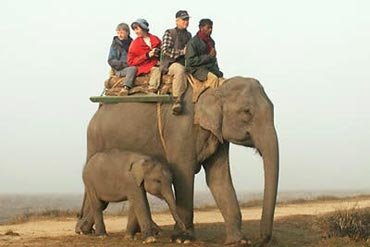Jim Corbett National Park
Corbett Tiger Reserve (CTR) is One of India's richest wilderness areas. The Tiger Reserve encompasses an area of 1288.34 sq km, which include two Protected Areas: Corbett National Park (520.82 sq. km) and Sonanadi Wildlife Sanctuary (301.18 sq. km)
Corbett National Park has captured the imagination of many with its diverse wildlife and breathtaking landscapes. The natural uniqueness of the area was recognised long ago and so in 1936 Corbett attained the distinction as the first national park to be established in mainland Asia. Corbett National Park lies in two districts – Nainital and Pauri – in the hill state of Uttaranchal in northern India. It covers an area of 521 sq. km and together with the neighbouring Sonanadi Wildlife Sanctuary and Reserve Forest areas, forms the Corbett Tiger Reserve over 1288 sq. km. Its geographical location between the Himalayas and the terai, and the streams, rivers and ridges crisscrossing the terrain, present Corbett with a remarkable variety of landscapes. This vivid mosaic of habitats – wet and dry, plain and mountainous, gentle and rugged, forests and grasslands – supports numerous plant and animal species, representing Himalayan as well as plains kinds. The most famous of Corbett’s wild residents are the Bengal Tiger and the Asiatic Elephant, but with about 600 species of avifauna Corbett is one of the richest bird regions of India.
Landscape and Geology
Himalayas and Shiwaliks
Mountains offer a great diversity of habitats due to variation in altitude, relief, and temperature. Consequently, mountain plant and animal communities have unique characteristics.
Corbett National Park is characteristic of the Himalayan mountain system. Corbett’s northern areas are lined by the Lesser Himalayan chain, which extends from Pakistan, through Jammu and Kashmir, Himachal, Uttaranchal, Nepal, Sikkim, Bhutan, and to Arunachal. The Lesser Himalayas are quite high, with an average altitude of 1800 m and are made up of crystalline rocks. The vegetation includes cold-climate tree species like pine, oak, and rhododendron. The Forest Rest House at Kanda at 1300 m is the highest point in the Park and is representative of the Lesser Himalayas
However, most of the Park lies in the Outer-Himalayan or Shiwalik region. The Shiwaliks are the southernmost of the Himalayan ranges and are much lower than the Lesser Himalayas. They are formed of sedimentary rocks and are hence crumbly and unstable. The Shiwaliks form the largest ridge across the park, running east to west from Dhangarhi to Kalagarh. These ridges are clothed by sal forests and other associates.
Duns
Between the Himalayan and Shiwalik mountain ranges lie elongated valleys called duns. Unlike typical river valleys, duns are formed not due to erosion but have a structural origin. They are covered with boulders and gravel originating from the erosion of the Himalayas and the Shiwalik uplands. One such dun occurs in the northern half of Corbett. This is the Patli Dun and is most visible from Dhikala. Kanda, being higher in the Park, presents a panoramic view of this valley.
Terai-bhabarTypical Shiwalik landscape
The southern boundary of Corbett flanks the ecologically important terai-bhabar region, a strip of land skirting the southern part of the Shiwaliks. It consists of the bhabar region, a narrow belt of sloping land located at the outer margin of Shiwaliks, and the terai swamplands that lie further south of bhabar.
The bhabar tract is porous because it consists mainly of gravel and boulders. It is devoid of streams or springs and water table is quite low. In contrast, the terai is swampy and humid, and contains many springs and slow-flowing streams. Most of the terai once held dense vegetation and was feared for malaria. It has been cleared for agriculture and is one of the most fertile grain production areas of India.
Together, the Terai-bhabar is a distinct ecological region, home to endangered wildlife such as the tiger, rhino, elephant, sloth bear, and vital habitat for for over 500 bird species.
Payment Option




About Us
Welcome to Online Corbett, northern India's nature and adventure tour specialists. We are one of the pioneers of wildlife safaris to Corbett Nnational Park in India. Generally most of the people think this site the official website of Corbett National Park but...
Read More...Corbett National Park
Corbett National Park has captured the imagination of many with its diverse wildlife and breathtaking landscapes. The natural uniqueness of the area was recognised long ago and so in 1936 Corbett attained the distinction asthe first national park to be established in mainland Asia...
Read More


